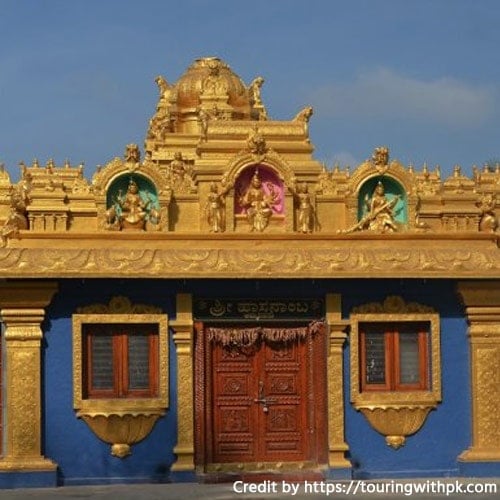Hasanamba Temple
Click the 'Play' button to read out loud this webpage content
Hassan is one of the districts of Karnataka and is known as the temple-architecture capital of the state. It is located about 180 km from Bangalore and has a well-connected transport system. It is close to other famous spots like Belur and Halebid, making it one of the tourist hubs in Karnataka. Among the popular places to visit is the Hasanamba Temple.
Introduction to Hasanamba Temple

Hasanamba Temple is one of the most famous temples in Karnataka. The city of Hasan gets its name from the presiding deity Hassanamba which in Kannada means 'Smiling mother’. The Temple is dedicated to Amba or the Goddess Shakti. It was built in the 12th century and is considered one of the ancient glory of the Hoysala empire. One of the significance of this Temple is that it is open once a Year during Deepavali in October. So anyone who wants to seek blessings of Hassanamba should come during this week.
History and Legends of Hasanamba Temple
The main tower of this Temple was newly constructed; however, there are two other major temples on the premises, which are dedicated to Ganapati and Siddeshwara, apart from Hasanmaba. It is said that earlier, Hassan was called Sihmasanapuri, and only much later goes this name. It is believed that during the 12th century AD, when the Hoysala were ruling, an idol was found which has a pleasant, smiling face, Hasana Mukhi. This was later accepted as the presiding deity of Hassan, and the name changed. The legend of Hassanamba Temple goes like this. The seven maatrukes namely the Brahmi, Kaumari, Maheswari, Vyshnavi, Indrani, Varahi, and Chamundi came to South India and then to Hassan. They fell in love with the beauty of this place and decided to make it their abode: Vyshnavi, Kaumari, and Maheswari residences on three anthills which were inside the Temple. Indrani, Chamundi, and Varahi chose Devigere Honda, while Brahmi resided in Hosakote. The town got named after the presiding goddess at the Hasanamba Temple.
The other story is that Hasanamna turned a mother-in-law who was torturing her daughter-in-law (a devotee of the goddess) into a stone. It is believed that the stone moves slightly every Year. The legend is that when the stones get to the feet of Hasanamba, Kaliyuga will end. Another story is that four robbers tried to rob Hasanamba of the jewels, and the goddess turned them into stones which can be seen in Kallappa Gudi.
The Architecture of Hasanamba Temple
The architecture of the temples details people about the different dynasties that ruled the place. The Temple of Hasanamba is a testimony of the greatness of the Hoysala architecture. The temples built around the time of the Hoysalas have a different feel about them. This, too, was built by a Hoysala dynasty king who was a follower of Jainism and had their traditions. The Temple is believed to be built around the 12th century and is one of the classic examples of the tradition of Temple architecture during those times. One of the significant things in this Temple is the image of Ravana with nine heads instead of ten and playing the musical instrument, Veena. Another unusual thing about the Temple is the view of the Siddeswara Temple from the entrance. It displays the trinity gods, Brahma, Vishnu, and Maheshwara.
Festivals Related to Hasanamab Temple
One of the most famous festivals conducted in this Temple is the Hasanamba Hatra Mahotsava which is held during the festive month of Deepavali. This Year, the festival will be held between October 13 and 27. It is the time when the historic Temple is open for devotees during the Ashwayuja month of the Hindu calendar.
During this time, the Goddess is worshipped with a lighted lamp, rice, flowers, and food which is needed for the rest of the Year. The lamp which is lit using ghee is called Nanda Deepa. The belief is that the lamp does not turn off and the rice bags do not get spoilt throughout the Year. Even the flowers placed remain fresh. It is a sight to behold as the lamp is always burning despite the Temple doors being closed.
Benefits of Worshipping in Hasanamba Temple
The Goddess is called Hasanamba as she is believed to be ever-smiling. She is a kind-hearted Goddess who bestows riches on her devotees. She is worshipped for being benevolent. She is also thought to be harsh on people who harm her devotees. So every Year, people wait for October or November when the Temple doors open to get her darshan and bestowed with all her blessings. Another significant fact is that the Temple is opened in the presence of the DC for 12 days. Devotees from across Maharashtra and other South Indian states come in huge numbers to get Hasanamba's blessings.
Temple Location and Timings of Hasanamba Temple
The Temple is located in Hassan city, about 180 km from Bangalore. The exact location of the Temple is
Hosaline Rd, Ammeer Mohalla, Hassan, Karnataka 57320
The timings are:
7:00 AM to 1:00 PM and 3:00 PM to 10:30 PM.
During the Deepavali season, it opens on the Thursday after the Aswin Purnima of the Hindu calendar and closes on Balipadyami Day.
How to reach Hasanamba Temple
By Air: The nearest airport to Hassan is Bangalore, as that city has no airport.
By Train: Ariskere railway station, which is about 38km from Hassan, is the nearest railway station to this Temple.
By Road: This is the best mode of transport to this Temple. It is well connected by frequent government buses from cities like Mysore, Mangalore, Bangalore, and more.
If you wish to have customized spiritual tours or pilgrimages arranged in India for yourself or for a group of people, please contact Brindavan Mystic Services
Email ID: [email protected] Toll free: 1800 102 9098